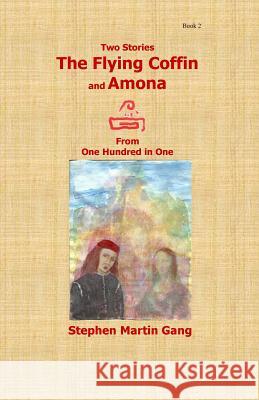The Flying Coffin and Amona: Two Stories From 100 in 1 » książka
The Flying Coffin and Amona: Two Stories From 100 in 1
ISBN-13: 9781514189221 / Angielski / Miękka / 2015 / 274 str.
The Flying Coffin and Amona: Two Stories From 100 in 1
ISBN-13: 9781514189221 / Angielski / Miękka / 2015 / 274 str.
(netto: 57,02 VAT: 5%)
Najniższa cena z 30 dni: 59,70
ok. 16-18 dni roboczych.
Darmowa dostawa!
This is the B&W edition of my second book from 100 in 1. The goal is to write 100 stories in one year. The first book "Ten Stories From 100 in 1" has been published and is available. These are the two longest stories written so far. Book 3 "Ten More From 100 in 1" will be published this Fall. While sitting in front of a glass of Merlot at the Mezzanine in Old San Juan, Puerto Rico I noticed a framed print of the Mona Lisa. It occurred to me that Mona Isla had one letter in a different place. Mona (Island) came from the Taino Amona meaning middle. It is also the name of a Cacique, which is the title of a Taino Chief. In Europe Mona is a given name and also the name of a Deity from Saxon mythology. I was aware the island was discovered the end of the fifteenth century, which was the same time Leonardo da Vinci lived and painted. The coincidence was too much for me to pass and my imagination stimulated. During the same period of noticing the Mona Lisa print I became aware of an African practice called Londola. The belief being the coffin of the murdered would fly to reveal the guilty. Naturally, this flight is assisted by men, and like a Ouija board can be manipulated. Things are never simple. Initially, the Spanish government charged the colonist with the responsibility to teach Taino Christian ways. The colonists used this power to make Taino slaves for personal profit. Within the following century the Taino, for all practical purposes, were wiped out. The Europeans brought diseases and horrific work conditions. The Taino were replaced mainly by slaves from Africa. The New World now consisted of a West Indies-Euro-African triangle. I wanted to tie all these thoughts together. I am not a historian, philosopher, physicist or scientist. However, all these disciplines interest me and I struggle to understand them on some level. My understanding may be shallow but it creates a gestalt for my thinking. An elementary field (Higgs Field) was a relatively new concept first suspected in the 1960s which the Boson-Higgs particle gave some credence to. Mass-less particles attain mass acquired from the energy in the Higgs Field. I wont attempt to explain what I don't understand and just say that within these theories are the concepts of symmetry and conservation. I believe it was the Hadron Collider which split a particle sending each half in opposite directions. At a fork each half seemed to pick a direction that sought wholeness again. No one knows what forces made the halves seek wholeness. Now, to complicate things further I started to think about determinism. This brings us to the seemingly unrelated two stories. For me they are the two halves. I perceive a loving couple as one. When that oneness is broken they are motivated to find oneness again. Slavery is what broke the symmetry for both stories and it seems wholeness is unsolvable. However, if you believe in reincarnation as mystical occurrence or believe in genetic memory, then the idea of losing symmetry doesn't exist. The puzzle is solvable over time. It takes five hundred years for Femi and Sani in the two stories to become whole again. They seem insignificant with all the other stories that surround them, yet perhaps their story is the most telling of all. Is it possible that the universe is subject to symmetry, even when an outside force seems to render something unsolvable? It may be that the outside forces which seems to break things apart is actually the mechanism by which things become whole again. It is a Buddhist idea that we seek oneness with the universe. And in both science and philosophy the idea of universal convergence is in the realm of possibility. Although the stories are fiction they are laced with historical facts. Stephen Martin Gang
Zawartość książki może nie spełniać oczekiwań – reklamacje nie obejmują treści, która mogła nie być redakcyjnie ani merytorycznie opracowana.











